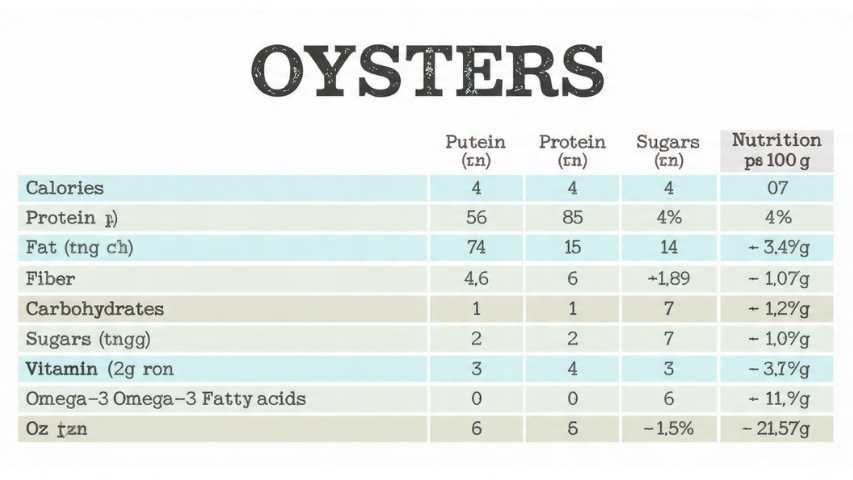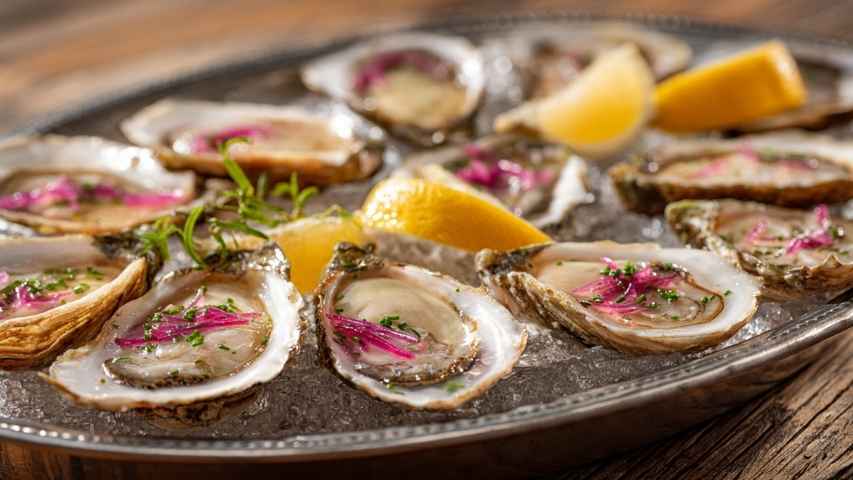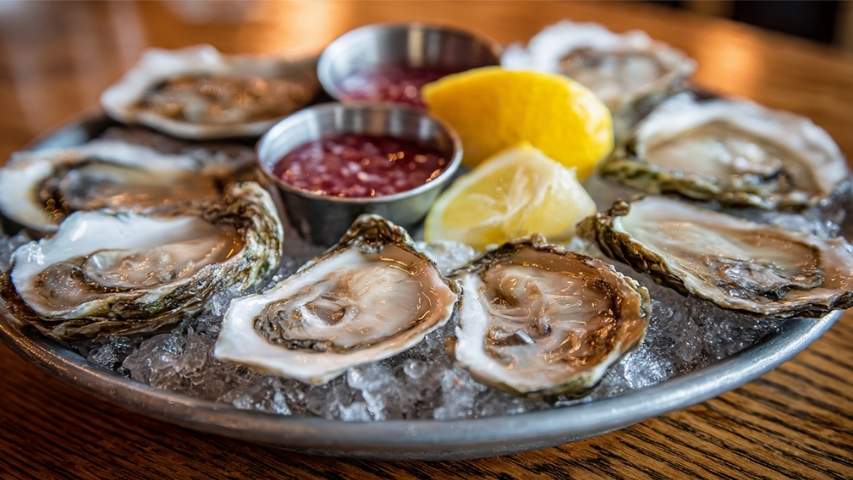Oysters tend to divide opinions at the table. Some people see a plate of fresh, raw oysters as the height of indulgence, enjoying the ocean flavor in every bite. Others are put off by the texture. No matter your preference, though, oysters are packed with nutrition.
People have eaten oysters for centuries, harvesting them from saltwater and enjoying many different types around the world. (Oyster, 2025) While some say oysters are an aphrodisiac, their proven health benefits are even more impressive. (Cording, 2025) Oysters can help your brain and immune system, making them a standout choice for nutrition. (The Health Benefits of Oysters, 2025)
But eating oysters does come with some risks. If you have ever hesitated before ordering raw oysters, your caution makes sense. Knowing how to choose, prepare, and eat them safely is just as important as knowing about their nutrients. This guide will cover both the benefits of oysters and how to avoid the risks.
The Nutritional Power of Oysters

If you want a low-calorie food that is full of vitamins and minerals, oysters are a great choice. They are nutrient-dense, so you get a lot of nutrition in a small serving.
According to nutritional data, a standard 3-ounce serving—which equates to about two medium or three small oysters—contains just 69 calories. Despite the low calorie count, this serving provides 8 grams of protein, making it a wise choice for those looking to maintain muscle mass without overeating. They are also low in fat (2 grams) and carbohydrates (4.2 grams). (Oyster Nutrition Facts and Health Benefits, 2025)
If you order a dozen oysters, the calories go up to about 413, depending on their size. (Fresh Oysters (12 Pcs) Nutrition Data and Calorie Count, 2025)
A Vitamin and Mineral Goldmine

Where oysters truly shine is in their micronutrient profile. They are not just a source of vitamins; they are an abundant supplier of them. A single serving offers exceptional levels of several key nutrients:
- Vitamin B-12: You get a staggering 567 percent of your daily value (DV). This is crucial for nerve function and energy production.
- Copper: Providing 149 percent of your DV, copper helps maintain healthy bones, blood vessels, and immune function.
- Zinc: At 128 percent of your DV, oysters are one of the best natural sources of this immune-boosting mineral.
- Selenium: With 119 percent of your DV, selenium acts as a powerful antioxidant. (Oysters Nutrition Facts, 2015)
Top Health Benefits of Eating Oysters
Thanks to their rich nutrients, adding oysters to your meals can help support important body functions. Here’s how these nutrients benefit your health.
Boosting Brain Health

As people get older, keeping the brain healthy becomes more important. Oysters are especially good for brain health because they have a lot of Vitamin B-12 and omega-3 fatty acids.
Vitamin B-12 is important for breaking down homocysteine. High homocysteine levels are linked to a higher risk of dementia and Alzheimer’s disease. Because oysters have so much B-12, they may help keep these levels in check.
Furthermore, the brain relies heavily on fats, specifically eicosapentaenoic acid (EPA) and docosahexaenoic acid (DHA), to function correctly. These are the most abundant omega-3 fatty acids found in the brain. Research indicates that individuals who have Alzheimer’s disease often exhibit lower levels of DHA, suggesting that a diet rich in these healthy fats is essential for long-term cognitive maintenance. (Omega-3 fatty acids and dementia, 2009, pp. 503-511)
Strengthening the Immune System
If you feel a cold coming on, skip the orange juice and reach for an oyster instead. Raw oysters contain the highest concentration of zinc of any food.
Zinc is a mineral your body needs for a strong immune system. It helps with DNA, healing wounds, and fighting off illness. Some studies say taking zinc within 24 hours of a cold can make it go away faster. (RM, 2013, pp. 233-243) Keeping your zinc levels up helps your body fight infections.
Fighting Fatigue and Anemia
Not getting enough iron is common and can make you feel tired, weak, or foggy-headed. Iron helps red blood cells carry oxygen through your body. Low iron can lead to anemia.
Oysters provide a specific type of iron known as heme iron. Unlike non-heme iron, which is found in plant-based foods, heme iron is derived from animal sources and is generally easier for the body to absorb. A standard serving of oysters delivers nearly 25 percent of your daily iron requirement, making them an excellent dietary addition for anyone struggling with low energy levels. (Oysters Nutrition Facts, 2025)
Potential Risks and Side Effects
Oysters have many benefits, but you do need to be careful. There are some health risks, especially if you eat them raw.
Bacterial Infections (Vibriosis)
The biggest risk with raw oysters is vibriosis, an infection from Vibrio bacteria found in coastal waters. Oysters filter water as they feed, so they can collect these bacteria in their bodies. (Vibrio and Oysters, 2024)
For most healthy individuals, vibriosis typically results in mild symptoms, such as diarrhea and vomiting. However, for those with compromised immune systems, the infection can be severe and even life-threatening. To minimize this risk, it is crucial to purchase raw oysters only from reputable food service establishments that adhere to strict safety guidelines.
Allergic Reactions
Shellfish allergies are common in both adults and children. This includes crustaceans like shrimp and lobster, and mollusks such as clams, mussels, and oysters. (Shellfish Allergy, 2025)
Allergy symptoms can show up quickly and range from mild to severe. Mild reactions may cause mouth itching or swollen lips. Moderate symptoms include nausea or stomach problems. In rare cases, a shellfish allergy can cause anaphylactic shock, which is life-threatening and needs emergency care.
Interactions with Medications
The high zinc in oysters can affect some medications. Zinc can make it harder for your body to absorb certain antibiotics, like quinolones (such as Cipro) and tetracyclines (such as Achromycin).
If you take these antibiotics, time your meals to avoid problems. Eat oysters at least two hours before or four to six hours after taking the medicine so it works properly.
Additionally, zinc can interfere with penicillamine, a drug used to treat rheumatoid arthritis. In this case, it is recommended to separate the consumption of zinc-rich foods and the medication by at least one hour. (C et al., 1976, pp. 241-247)
How to Prepare and Store Oysters Safely
If you want to eat oysters at home, it’s important to handle them safely. Oysters spoil quickly, and improper handling can cause food poisoning.
Cleaning and Shucking
Before opening oysters, clean them first. Scrub the shells with a brush to remove dirt. Then soak them in cold salted water (1/4 cup salt per 4 cups water) for at least an hour. This helps them get rid of any sand or grit inside.
If you find an oyster with a broken shell or one that stays open when tapped, throw it out right away. This means the oyster is dead and not safe to eat.
To shuck an oyster:
- Gear up: Wear work gloves to protect your hands from the sharp shell and the knife.
- Position: Place the oyster on a folded kitchen towel with the deeper cup side facing down.
- Pry: Insert an oyster knife into the hinge (the pointy end). Twist firmly until the shell pops open.
- Cut: Slide the knife along the top shell to cut the muscle, then remove the top shell.
- Clean: Remove any stray bits of shell and slide the knife under the meat to detach it from the bottom shell.
Cooking: The Steaming Method
Cooking oysters destroys harmful bacteria, making it a safer option than eating them raw. (Vibrio and Oysters, 2024) Steaming is a popular method that preserves the flavor:
- Arrange scrubbed oysters in a steamer basket.
- Bring a pot of water to a boil and place the basket over it (ensure the water doesn’t touch the shells).
- Cover and steam until the shells open.
- Discard any oysters that fail to open after cooking.
Storage Tips
Never leave fresh oysters out at room temperature. Always keep them cold.
- To store oysters in the fridge, put them in a bowl and cover with a damp towel. Don’t put them in fresh water, or they will die. Eat them within a few days.
- You can freeze live oysters in their shells for 3 to 6 months. (Handling and Processing Oysters, n.d.) Put them in vapor-resistant bags and remove the air. You can also freeze shucked oysters in a sealed container with their liquid.
Frequently Asked Questions
Can you tell if an oyster is bad without opening it?
Yes. A live oyster’s shell should be tightly closed. If it’s slightly open, tap it. If it closes, it’s alive. If it stays open, it’s dead and should be thrown out. Bad oysters also smell unpleasant, not fresh and briny.
Is it safer to eat cooked oysters than raw ones?
Yes. Cooking oysters to 145°F kills Vibrio bacteria that can make you sick. If your immune system is weak, it’s best to eat only cooked oysters.
Do cooked oysters have the same nutrition as raw ones?
Generally, yes. Cooking may lower some water-soluble vitamins, but oysters are still a great source of protein, zinc, iron, and B-12. (Oysters: Nutrition, Risks, and How to Cook Them, 2025) The safety benefits of cooking usually outweigh the small loss of nutrients.
A Nutrient-Dense Delicacy
Oysters aren’t just a special treat—they’re a true superfood that can help your brain, energy, and immune system. Their high zinc, B-12, and iron make them a smart part of a balanced diet. But since they filter water, they do carry some risks from bacteria and spoilage.
If you buy oysters from trusted sources and handle them safely, you can enjoy their briny flavor and health benefits. Whether you steam, stew, or eat them raw, oysters are one of the ocean’s most nutritious foods.


















